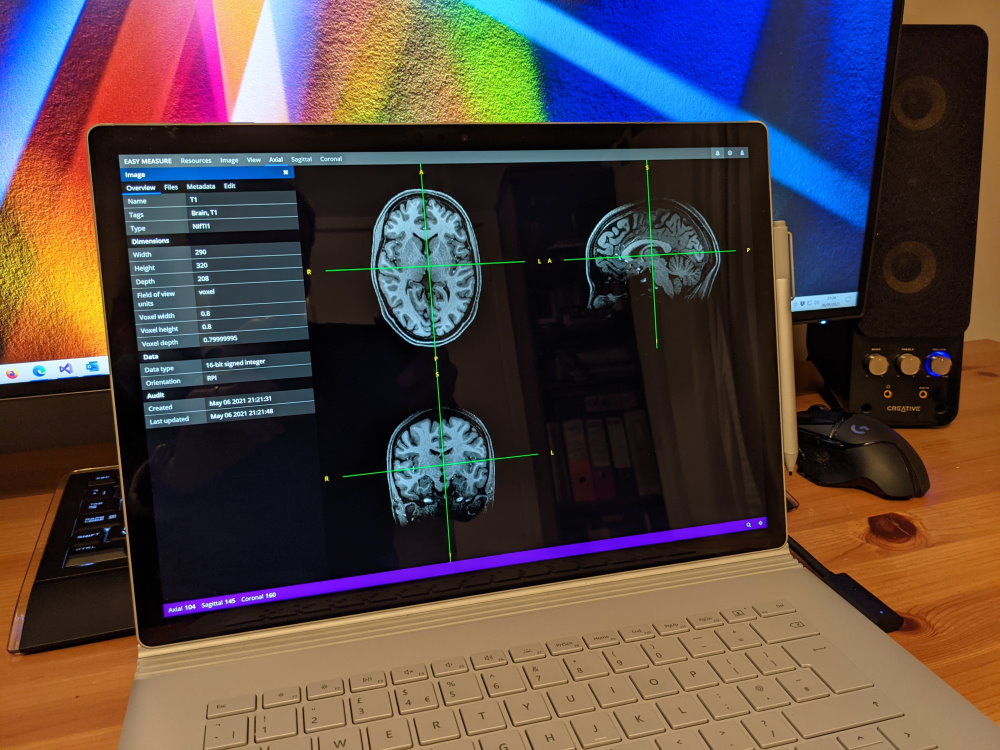It's been a while since our last release note, but rest assured we've been working flat out to bring you new features and improvements. Here's what's new in version 0.12.
Tags
Tags are a new resource that allow you to group and categorise images and experiments within EASY MEASURE. Once you have created a set of tags, they can be assigned to images and experiments. The assignment can happen when you create (import or run) an image or experiment, or later when you edit an image or experiment.
You can create tags for any purpose, with any name. For example, you might create tags that identify a patient (e.g. 1112345632), a study (e.g. Encephalitis), a modality (e.g. MRI), an MRI sequence (e.g. T1) or a year (e.g. 2021).
Tags can be accessed and maintained via the View all tags menu item, found under the Resources menu. To create a new tag, click on the plus (+) symbol in the top right hand corner of the View all tags screen. You will be prompted to enter a tag name and, optionally, notes that describe your tag.
By default, the View all tags screen lists newest tags first, but you can sort tags by name or last updated date and it is also possible to filter tags by name.
To update or delete a tag, click on the name of the relevant tag and a screen will open with options to edit or delete the selected tag.
Image and experiment lists
The View all images and View all experiments screens have been updated to support sorting and filtering.
Initially the View all images screen shows most recently uploaded images first, but you can sort images by name or last updated date and you can also filter images by name and tags.
Similarly, the default View all experiments screen shows most recently run experiments first, but you can sort experiments by name or last updated date and you can filter experiments by name, image and tags.
Image import
The maximum import dimensions for Analyze and NIfTI-1 images has been increased from 512 x 512 x 512 to 640 x 640 x 640.
The assumed anatomical orientation for Analyze and NIfTI-1 images when qform_code = 0 and sform_code = 0 has been changed from RAI to RPI. This is to ensure consistency with legacy EASY MEASURE.
A new image type called Raw helps facilitate the upload of unsupported images to EASY MEASURE. When you select the Raw image type on the Import an image screen, a number of fields appear that must be manually populated, including:
- Dimensions (width, height, depth, field of view units, voxel width, voxel height and voxel depth)
- Datatype (8-bit / 16-bit / 32-bit, signed / unsigned / float)
- Swap bytes (enable if voxel data big-endian)
- Voxel offset (offset in bytes, from start of image, after which voxel data starts)
- Orientation (a 3 letter code comprising the letters R, L, S, I, A, P determining anatomical orientation of voxel data)
Although not intended for this purpose, you could use the Raw image type to upload a supported image type, such as Analyze or NIfTI-1, in order to override metadata found in those files.
Cavalieri volume
A number of improvements have been made to Cavalieri volume experiments, which enable the unbiased estimation of structure volume via the Cavalieri method.
- A new Exclusive option prevents points being counted in multiple structures. You should enable this option when estimating the volumes of mutually exclusive structures.
- Auto count allows EASY MEASURE to automatically count points that fall within a given voxel intensity range. To use this feature, enable Auto count and specify an intensity range on the Run Cavalieri volume experiment screen.
- A new Edit Cavalieri volume experiment screen allows you to change certain attributes of in-flight Cavalieri volume experiments, such as add, remove or update structures and change the appearance of points.
- The currently active structure is displayed in the status bar, along with a checkbox that determines whether counted points belonging to the active structure are displayed or hidden.
Continuous integration and deployment improvements
Around the start of the year, we kicked off a project to improve our Continuous Integration (CI) and Continuous Deployment (CD) pipelines. This has resulted in our being able to deploy code changes in a fully automated way, which means we can release new features and code changes faster than before, with the added benefit of increased security and reliability.

